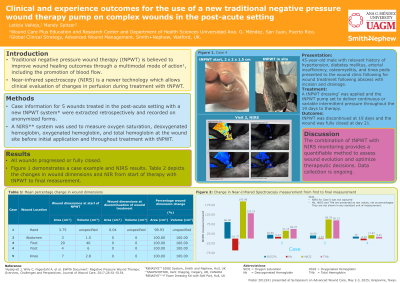Practice Innovations
(PI-046) Clinical and Experience Outcomes for the Use of a New Traditional Negative Pressure Wound Therapy Pump on Complex Wounds in the Post-acute Setting
Friday, May 2, 2025
7:45 PM - 8:45 PM East Coast USA Time

Mandy Spitzer, MBA, RN, CWOCN, CFCN
Introduction: Traditional Negative Pressure Wound Therapy (tNPWT) is often associated with complex dressing and pump operation1, which can lead to increased clinician time and decreased patient concordance to therapy2. A new tNPWT system has been introduced which was specifically designed to improve upon the barriers often associated with tNPWT.
Methods: Case information for 25 wounds treated in the post-acute setting with the new tNPWT system were extracted retrospectively and recorded on anonymized forms. Patient demographics, comorbidities, wound type, location, and characteristics were recorded. Therapy delivery modes and written and visual depictions of dressing application techniques and products used were captured. Near-infrared spectroscopy (NIRS) was utilized to measure the influence of NPWT on oxygen saturation, oxygen-carrying hemoglobin, and total hemoglobin at the wound site before initial application and throughout treatment with tNPWT.
Results: Twenty-five wounds were treated with the new tNPWT system, many of which required complex dressing application and adjunctive product use. This real-world dataset evaluates the use of the new tNPWT system, recording the wound and patient outcomes and the clinician experience with its use across multiple visits and dressing applications. The data demonstrates both the healing outcomes and provides insight into complex dressing applications through wound and dressing imagery, measurements, and the NIRS results.
Discussion: This data collection supports the efficacy of this new tNPWT system, demonstrating the varied approaches to application and the resulting wound outcome and use experience. The documentation of the wound outcomes in combination with the NIRS results supports the use of tNPWT for chronic and complex wound care in the post-acute setting.
Methods: Case information for 25 wounds treated in the post-acute setting with the new tNPWT system were extracted retrospectively and recorded on anonymized forms. Patient demographics, comorbidities, wound type, location, and characteristics were recorded. Therapy delivery modes and written and visual depictions of dressing application techniques and products used were captured. Near-infrared spectroscopy (NIRS) was utilized to measure the influence of NPWT on oxygen saturation, oxygen-carrying hemoglobin, and total hemoglobin at the wound site before initial application and throughout treatment with tNPWT.
Results: Twenty-five wounds were treated with the new tNPWT system, many of which required complex dressing application and adjunctive product use. This real-world dataset evaluates the use of the new tNPWT system, recording the wound and patient outcomes and the clinician experience with its use across multiple visits and dressing applications. The data demonstrates both the healing outcomes and provides insight into complex dressing applications through wound and dressing imagery, measurements, and the NIRS results.
Discussion: This data collection supports the efficacy of this new tNPWT system, demonstrating the varied approaches to application and the resulting wound outcome and use experience. The documentation of the wound outcomes in combination with the NIRS results supports the use of tNPWT for chronic and complex wound care in the post-acute setting.

.jpg)